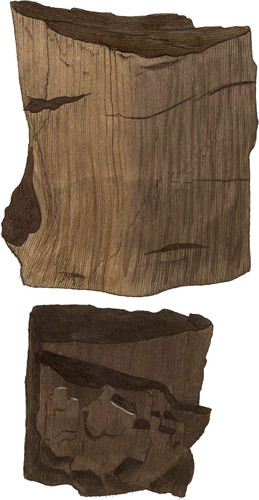 Enlarge
Enlarge
British Mineralogy
Bituminous Oxide of Carbon, or Bovey Coal
- Class 1. Combustibles.
- Order 3. Mixed.
- Syn.
- Bovey Coal. Hatchett in Phil. Trans. for 1804. 385.
- Compact Carbonated Wood. Kirw. 2. 61.
Bovey, in Devonshire, has been some time famous for affording a fossilized wood of a nature rather peculiar to the place, commonly called Bovey Coal. I was prevented examining the place when I went that way, by want of time. Indeed there was little necessity for it; as the Rev. Mr. Rackctt, Dr. Maton, Mr. Hatchett, &c. were more competent to the purpose: see Maton’s Tour, 187. Linn. Trans. v. 4. 138. Although Mr. Hatchett examined the matter a second time, and would not venture to offer any opinion on the subject, T am highly indebted to my good friend the Rev. Dr, Beeke for procuring and assisting me with the best information concerning the particular nature of the change wrought on the wood as it advances towards the most perfect Bovey Coal.
It appears that the main dip is from south to north, and that, as Mr. Hatchett observes, the upper or southernmost end terminates like the remains of a bog, and the rest declines with an appearance of a continuation of this bog sunk downwards, forming the dip. The upper part contains stumps and broken remains of shrubs and trees, very little changed; a little way down they are somewhat resinously bituminized; see tab. 187, and the appearance of wood is still very distinct. To the touch they are greasy, and will readily polish with a slight application of the finger nail, being as it were saturated or closed with bituminous matter. In some places the resinous Asphaltum is intermixed; see tab. 186: in other places is seen the resino-bitumiuous wood, as it were burnt, or formed into common charcoal, tab. 187. The most perfect Bovey Coal is found at the greatest depth, being as it were a compound of these two, with the bituminous principle less resinous and the Coal more indurated, forming a wood -like bituminous coal. There are 17 strata found in intermediate gradations, composed of many varieties, depending on their situations: the lowest most perfect, about 70 feet deep or more, where the various pressures, and the state of confinement of the different strata, retard or accellerate the process. It seldom forms a large piece of black Surturbrand, although the charcoal before mentioned is as black as common charcoal. It, however, is often very dark-coloured, like part of the lowest figure, and is used as coal by the poor in the neighbourhood, and at a pottery, established on purpose, as I understand, to turn it to account. The smell, however, is offensive to most strangers, from its not being a true charcoal.
“It burns to a charcoal,” as Mr. Hatchett observes, “readily, with a flame, like half-charred wood. It does not crackle; and, if completely burned, leaves a quantity of white ashes, exactly similar to those of wood.”
If I might hazard a conjecture, the place seems suited to the phenomenon; the dip is from the south, where a wood and a bog (as I am informed) rise, as it were, out of the earth; or in other words, the northern side of this boggy wood is lowest, and has become gradually buried.
In the vicissitudes and changes that are natural to certain parts of the globe, we find plains formed between hills and mountains, lakes and rivers made level. Should this place formerly have been a large bog, the lowermost and deepest part of which, according to Dr. Maton, v. 1. 107, rests on a bed of sand now seventeen feet deep, it may have sunk into spaces for springs, Sec. and that at seventeen different periods, between each of which there was time sufficient for the forming of fresh wood and fresh clay, in adequate proportion to the thickness of each stratum, as the sinking of the wood was probably followed by something of an inundation, whether quick or slow. Thus the change of the wood might be effected; the lowest or oldest being nearest, when compared with the rest, to perfect coal. The strata here are, however, less dense and looser than that under which the Northern or Newcastle Coals are formed; consequently it is a series pointing out something like a modern formation, giving us apparently a hint of the commencement of a more remote one. The cause, I think, may be presumed adequate to the effect; if we suppose a more or less perfect communication (according to the time of the falling of the first stratum) with the external southern aspect, the effects of wet and dry would rot the wood, and an evaporation would more or less be carried on, so as to accomplish the changes here seen; the upper strata being least changed, and only rotting by imbibing and evaporating moisture night and day, winter and summer. The resinous or bituminous parts have been more or less allowed to evaporate, according to the pressure; at the surface but little, and at the bottom scarcely at all, being out of the reach of perceptible change; and as it loses its most volatile principles, the more durable woody principle, or carbon, will last for ages, like a post charred to preserve it from the damps when put into the ground, which is so rendered extremely durable. We are sure to find that the post rots where there is most vicissitude of wet and dry, or nearly on the surface of the ground, and sometimes the damps will penetrate and rot the inside of the charred part winch is itself almost indestructible.

